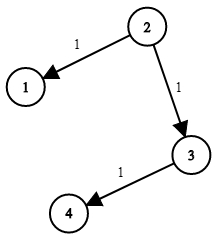Network Delay Time
Description
There are N network nodes, labelled 1 to N.
Given times, a list of travel times as directed edges times[i] = (u, v, w), where u is the source node, v is the target node, and w is the time it takes for a signal to travel from source to target.
Now, we send a signal from a certain node K. How long will it take for all nodes to receive the signal? If it is impossible, return -1.
Example 1:

Note:
Nwill be in the range[1, 100].Kwill be in the range[1, N].The length of
timeswill be in the range[1, 6000].All edges
times[i] = (u, v, w)will have1 <= u, v <= Nand0 <= w <= 100.
Solution
This problem is equivalent to the problem of finding the shortest paths between a node and all other nodes.
Dijkstra's algorithm
Running time: .
Last updated